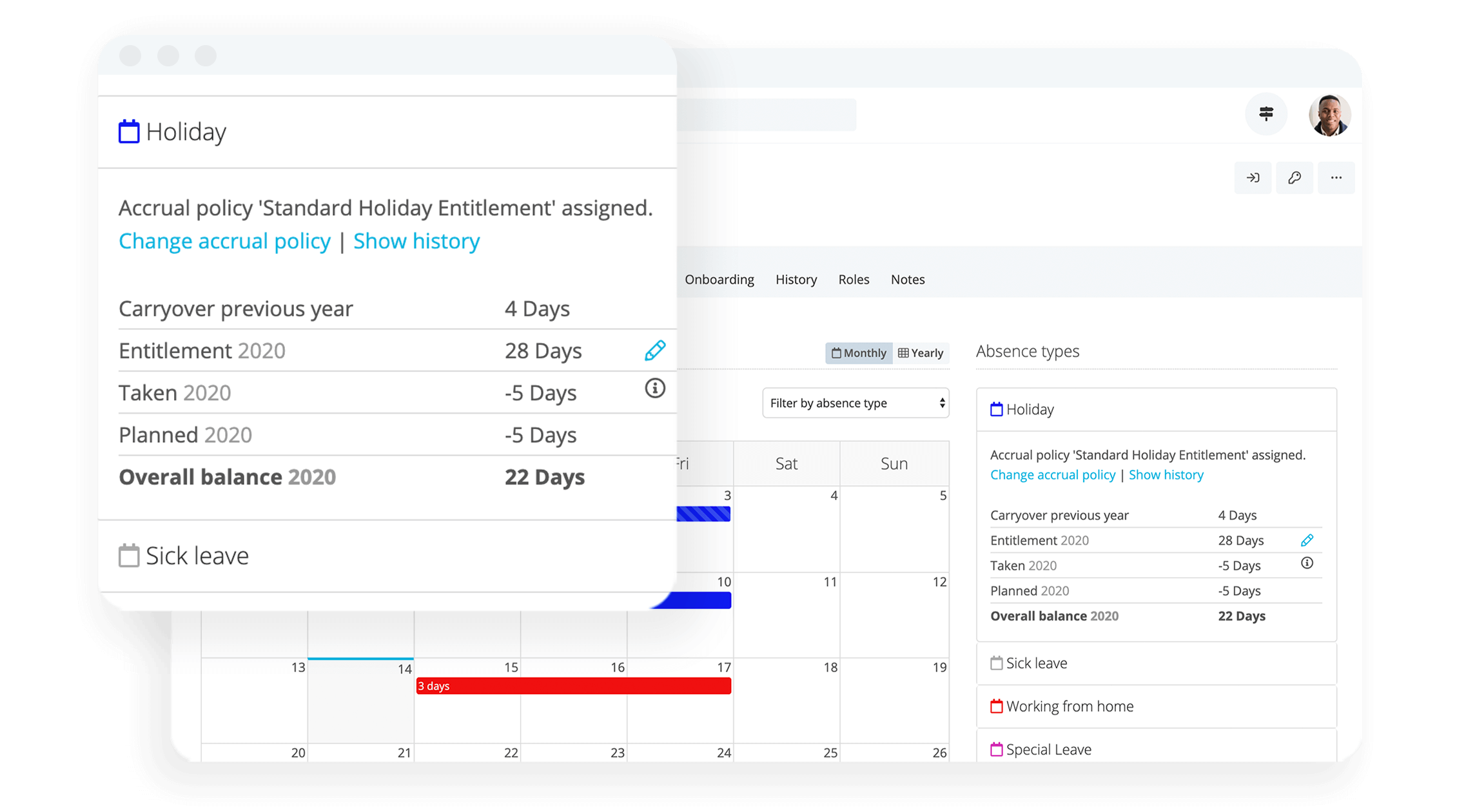
14-Day Free Trial
Track leave, illnesses and bank holidays from one place: Personio.
Book your free demoShared Parental Leave: Facts and Examples
Shared Parental Leave is a type of leave that new parents can take during the first year of their child’s life — or the year after the child is placed with them in the case of an adoption.
As an employer, you need to understand the ins and outs of Shared Parental Leave, so you know what to do if one of your employees requests it. Read on for our full guide to Shared Parental Leave for employers.
Key facts:
Shared Parental Leave (SPL) is a type of leave that employees can take when they or their partner has a baby, or when they adopt a child. It can be shared between the birth mother/primary adopter and their partner.
Employees can take up to 50 weeks of Shared Parental Leave, and receive up to 37 weeks of Statutory Shared Parental Pay (ShPP), depending on their circumstances.
There are a number of different ways that parents can use Shared Parental Leave. Both partners can take their leave together, or they can alternate which partner is on leave. Or, one parent can take all of the Shared Parental Leave in several blocks throughout the year.
What Is Shared Parental Leave?
Shared Parental Leave (SPL) is a type of leave that’s available to new parents — whether or not they’re the birth mother or primary adopter of their child. The idea behind Shared Parental Leave is to provide different options to new parents when it comes to caring for their child. Shared Parental Leave can be divided between the two parents in a few different ways — we’ll provide some examples below.
How Does Shared Parental Leave Work?
Shared Parental Leave allows parents more flexibility in how they care for their child in the year after its birth or adoption. The mother or primary adoptive parent can choose to convert part of their maternity or adoption leave into Shared Parental Leave. They can then share this with their partner, so they can take a more active role in caring for their child. Parents can take this leave separately throughout the year, or take it at the same time.
Who Is Entitled to Shared Parental Leave?
Shared Parental Leave is available to parents who are having a baby, using a surrogate to have a baby, adopting a child or fostering a child with a view to adopting them.
The eligibility criteria for Shared Parental Leave are slightly different depending on the parents’ situations. But in all cases, the two parents must have shared responsibility for the child, either from their date of birth (or due date) or the date the child is placed with the parents if they are adopting.
There are also rules about the number of weeks that each parent must have worked in the months leading up to the birth or adoption of the child, and how much they need to have earned during that time. HMRC have created a useful tool to help employees figure out how and when they can take Shared Parental Leave, and how much Statutory Shared Parental Pay they’re entitled to.
How Much Shared Parental Leave Are Employees Entitled to?
Eligible parents can get up to 50 weeks of Shared Parental Leave, depending on how much maternity leave or adoption leave the birth mother or primary adopter has taken. Essentially, any maternity or adoption leave that the mother or primary adopter takes is deducted from the total that can be used as Shared Parental Leave. This doesn’t include the first two weeks (or four weeks if the mother works in a factory) after the baby is born, since this is mandatory leave that the birth mother has to take.
Statutory Shared Parental Pay (ShPP)
Statutory Shared Parental Pay (ShPP) is a payment that parents can receive instead of Statutory Maternity Pay (SMP). It can be paid to either partner, depending on who is taking the Shared Parental Leave.
ShPP is paid for up to 37 weeks, at the same rate as Statutory Maternity Pay, which is either £172.48 per week or 90% of your average earnings, whichever is lower. The only difference is that SMP is paid at 90% of earnings for the first six weeks, without an upper limit.
When Can Shared Parental Leave Start?
Shared Parental Leave can start when either:
The mother or primary adopter has returned to work, ending their maternity leave or adoption leave
The mother or primary adopter has given their employer ‘binding notice’ of the date when they plan to end their maternity leave
Review, approve and track absences from one place: Personio

Seamless absence management that scales with your headcount. See how Personio can manage every type of leave for your organisation today.
Absences with PersonioTaking Shared Parental Leave in Blocks
Employees can take their Shared Parental Leave in up to three different blocks of leave during the first year after the birth or adoption of their child. These blocks must be made up of at least a week, and can’t be used to reduce working hours (e.g. by taking SPL for two days a week and working the other three days).
You don’t have to let your employees split their leave into more than three blocks — though you can if you want to. Employees need to tell you about their leave plans when they apply for Shared Parental Leave. They can change these plans later, but they need to give you at least eight weeks’ notice for any changes.
Shared Parental Leave Examples
Here are some examples of how parents might decide to use their Shared Parental Leave, to help you understand the various ways it can work.
Example #1: Mother Shares Unpaid Leave With Her Partner
Bob and Susan are expecting a baby. Susan decides that she will only take the paid portion of her maternity leave, and will return to work after her entitlement to Statutory Maternity Pay ends at 39 weeks. This leaves her with 13 weeks of unpaid leave that she can share with Bob.
Bob takes two weeks of Statutory Paternity Pay after the baby is born, then returns to work. He then takes 13 weeks of unpaid leave after Susan returns to work.
Example #2: A Couple Splits Leave and Pay Equally
Mary and John are adopting a baby. They decide that they will split the leave and pay that they are entitled to equally. Mary is the primary adopter, who would normally be entitled to 52 weeks of adoption leave. John is entitled to two weeks of Paternity Leave from the child’s placement date. He then returns to work.
Mary ends her adoption leave after 26 weeks, leaving 26 weeks of leave and 13 weeks of pay for John to take. After Mary returns to work, John takes 26 weeks of leave. For the first 13 weeks, he receives £172.48 per week as Statutory Shared Parental Pay. The remaining 12 weeks are unpaid.
Example #3: A Partner Takes Leave in Blocks
Sally and Tom are having a baby, and decide to share their leave and pay equally. Like Mary, Sally takes 26 weeks of maternity leave, and receives Statutory Maternity Pay during this time. This leaves 26 weeks of leave and 13 weeks of pay that Tom can take.
Unlike John, Tom decides to take the first 13 weeks of Shared Parental Leave immediately after his two weeks of Statutory Paternity Leave. During this time, he receives ShPP at £172.48 a week. He then returns to work until Sally ends her maternity leave. Once Sally has returned to work, Tom takes a further 13 weeks of (unpaid) Shared Parental Leave.
Frequently Asked Questions About Shared Parental Leave
Here are the answers to some FAQs about Shared Parental Leave:
What Is Shared Parental Leave?
Shared Parental Leave is a type of work leave that employees can take when they have a baby. It allows the parents to equally divide the leave they get after the baby is born or adopted, if they choose to do so.
How Many Days of Shared Parental Leave Do Employees Get?
Employees can get up to 50 weeks of Shared Parental Leave, which is the equivalent of the 52 weeks of Statutory Maternity Leave, minus the two weeks of compulsory leave that the mother must take after giving birth.
Managing Absences With Personio
Shared Parental Leave is just one of many types of leave that your employees might be entitled to — and keeping track of them all can quickly get confusing for HR teams.
HRIS software like Personio can help you to oversee which employees are off work, for how long, and for what reason. This means you can better plan for absences and ensure they don’t derail your operations and impact productivity.
Want to learn more about Personio’s absence management features? Book a free demo to get started.
